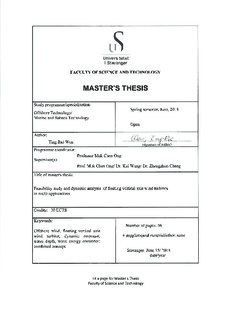| dc.description.abstract | In the past decades, the global wind energy has rapidly grown. Greater potential of wind recourses is explored in the deeper sea; hence, wind farms have progressively moved toward the deep water over the years. Floating wind turbines then become an available solution which could be widely applied to deep water. Spar, semi-submersible and tension-leg platform (TLP) are the main types of floating substructure for supporting the wind turbine. The wind turbine can be generally categorized into horizontal axis wind turbine (HAWT) and vertical axis wind turbine (VAWT) in terms of the direction of the rotating axis. Compared to floating HAWTs, floating VAWTs have several advantages such as lower maintenance and operational costs etc. The deployment of floating VAWTs starts to arouse people’s attention. Recently, the applications of floating VAWTs in deep water have been studied by several researchers. However, the feasibility of deploying a floating VAWT at a moderate water depth has not yet been discussed. In addition, offshore wind energy is not the only source to produce power in a marine environment. Wave energy exists huge potential to be utilized. The combined concept that can harvest both wind and wave resources becomes another alternative solution, which could lower the cost and increase the power efficiency. Several concepts of the integrated system which combines a floating HAWT and a wave energy converter (WEC) have been proposed and discussed, such as a semi-submersible HAWT with the flap-type WEC, a combination of spar-type HAWT and a torus-shape WEC, etc. Considering the advantages of the floating VAWT, an integration of the WEC and the floating VAWT deserves a further investigation and evaluation. This study is inspired by the merits of the floating VAWT and the successful experience of the Hywind project in Scotland. The thesis aims to investigate and assess the feasibility of the spar-type VAWT in multi-applications. A short spar VAWT at moderate water depth and a combined torus-shape wave energy converter and spar-type VAWT concept (STC VAWT) in deep water are studied under operational conditions. Both concepts are compared with a spar-type VAWT in deep water to evaluate its advantages and disadvantages. In the first concept, a short spar VAWT supporting a 5 MW Darrieus rotor at moderate water depth is proposed by following the deep spar concept in deep water. This feasibility is thoroughly addressed by comparing the dynamic responses of spar-type VAWTs in deep water and moderate water depth. A fully coupled simulation tool, SIMO-RIFLEX-DMS code, is utilized to carry out time domain simulations under turbulent wind and irregular waves. Dynamic responses of the short spar and deep spar VAWTs are analyzed and compared, including the natural periods, wind turbine performance, platform motions, tower base bending moments, and tension of mooring lines. The statistical characteristics of the thrust and power production for both spars are similar. The comparison of platform motions and tower base bending moments demonstrate a good agreement for both spars, but the short spar has better performance in surge/sway motions and side–side bending moments. The 2P response dominates the bending moment spectra for both spars. A significant variation in tension of Mooring Line 1 and a larger corresponding spectrum value are found in the short spar concept. The results indicate that the application of short spar VAWTs is feasible and could become an alternative concept at moderate water depth. An integration of spar-type VAWT and a torus-shape wave energy converter (STC VAWT) is considered in the second concept. This combined concept utilizes the relative heave motion between the torus and the spar buoy to harvest the wave energy. An integrated aero-hydro-servo-elastic tool (SIMO-RIFLEX-DMS code) is used to study the power performance and the dynamic response of the STC VAWT under operational conditions with the combinations of turbulent wind and irregular wave. The strength and weakness of the second concept are explored in comparison with the spar-type VAWT. The WEC can provide additional power and increase the total amount of production in the combined concept. The 2P loadings of the STC VAWT show a good agreement with the spar-type VAWT. The additional torus is exposed to lager wave excitation force, which leads to significant variations of hydrodynamic loads on the STC. The torus acts as a damper at the mean sea level, which could mitigate the variation of the floater motion in surge/sway/pitch. The heave natural period of the STC system is in the same range with ocean wave periods. A larger heave response may be excited during operation, whereas it is beneficial for wave energy absorption. The statistical result indicates that the STC gives larger standard deviations of tower base bending moments than the spar-type VAWT, which is due to the torus effect. The larger variations of the tension of Mooring 1, which is aligned with the wind and waves, are also observed in the combined concept. Overall, the STC VAWT is applicable in the operational stage, and a further study on the current condition or extreme environments is recommended in the future. | nb_NO |

